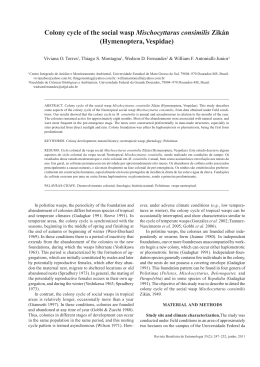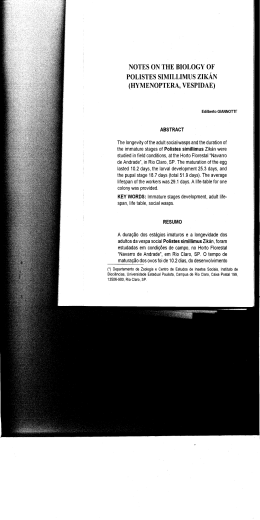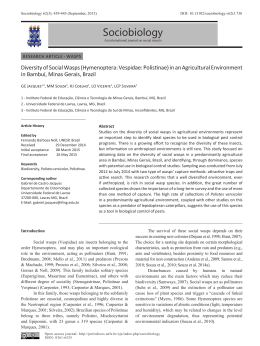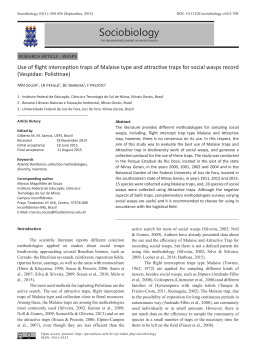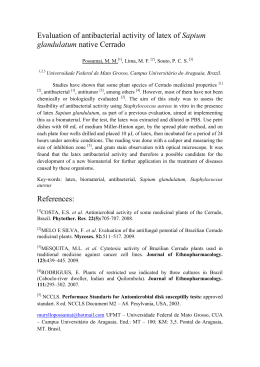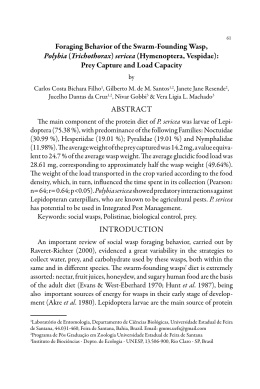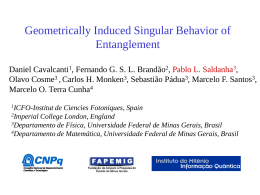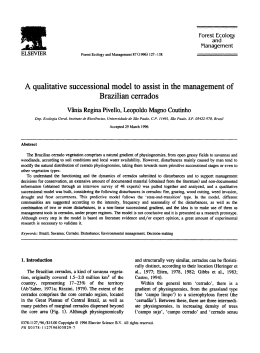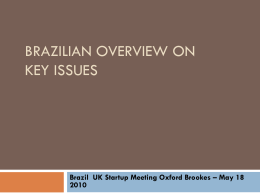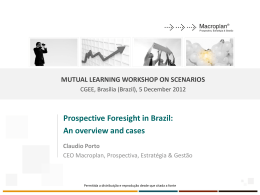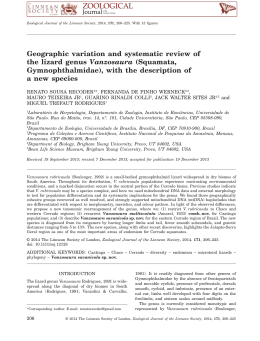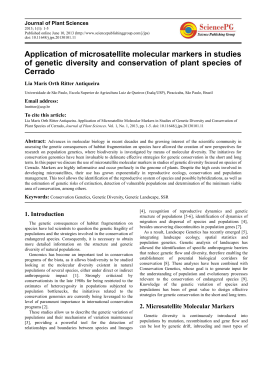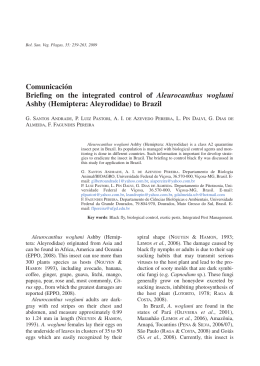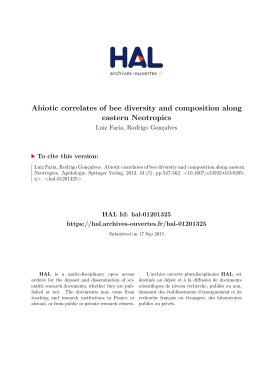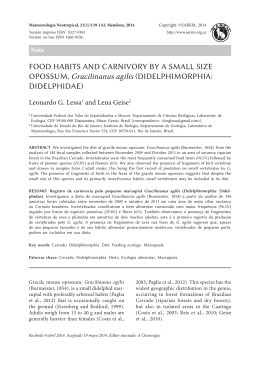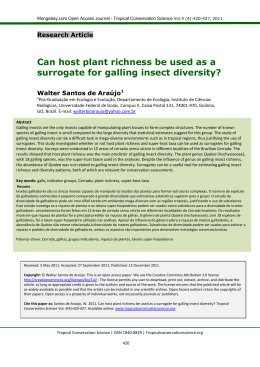539 Original Article SEASONAL RICHNESS AND COMPOSITION OF SOCIAL WASPS (Hymenoptera, Vespidae) IN AREAS OF CERRADO BIOME IN BARROSO, MINAS GERAIS, BRAZIL RIQUEZA SAZONAL E COMPOSIÇÃO DE VESPAS SOCIAIS (Hymenoptera, Vespidae) EM ÁREAS DE CERRADO EM BARROSO, MINAS GERAIS, BRASIL Marcos Magalhães de SOUZA1; Epifânio Porfiro PIRES2; Fábio PREZOTO3 1. Professor, Doutor, Instituto Federal de Educação e Tecnologia do Sul de Minas, Campus Inconfidentes, Inconfidentes, Minas Gerais, Brasil. [email protected]; 2. Biólogo, Mestre em Agronomia/ Entomologia, Departamento de Entomologia, Universidade Federal de Lavras, Lavras, Minas Gerais, Brasil. [email protected]; 3. Professor, Doutor, Departamento de Zoologia, Universidade Federal de Juiz de Fora, Juiz de Fora, Minas Gerais, Brasil. [email protected]. ABSTRACT: The study evaluated the seasonal richness and composition of social wasps in Cerrado transition areas and Atlantic Forest in the municipal district of Barroso (Cerrado Grassland, Semidecidual Forest and Anthropic Areas). Thirty-eight species of social wasps were recorded, distributed in 10 genera and 127 colonies. The phytophysiognomy of Cerrado Grassland had the highest number of species (35) and colonies (76), followed by Semidecidual Forest (26 species and 37 colonies) and Anthropic Areas (nine species and 14 colonies). Agelaia vicina (Saussure, 1854) showed the highest constancy, present in 57.7% of collections. The number of social wasp species and colonies was positively correlated with temperature and precipitation. The hot and humid season is the most favorable period for social wasp population growth. KEYWORDS: Mata do Baú. Polistinae. Vespidae. Colonies. INTRODUCTION The variations between climate zones affect population distribution, biodiversity and insect frequency (JANZEN, 1973; WOLDA, 1978, 1988; GASTON, 2000). The marked reduction in the abundance of insect populations between the dry and rainy seasons seems to be restricted to tropical environments (JANZEN; SCHOENER, 1968; WOLDA, 1980). Various studies have shown evidence that tropical insects undergo seasonal alterations in abundance, particularly in regions where the dry and rainy seasons alternate (WOLDA, 1978; WOLDA; FISK, 1981). Social wasps are insects belonging to the order Hymenoptera, family Vespidae and are currently divided into two subfamilies: Vespinae and Polistinae (CARPENTER, 1981). About 970 species are described worldwide. In Brazil, all social wasp species belong to subfamily Polistinae, with 319 species recorded in the entire country (CARPENTER; MARQUES, 2001). These organisms play an important role in communities, both in natural and agricultural ecosystems, carrying out pollination or by exercising predation pressure on populations of other organisms (CARPENTER; MARQUES, 2001; SOUZA et al., 2010; SOUZA; ZANUNCIO, 2012). Several studies have shown that temperature and precipitation influence Received: 06/01/13 Accepted: 05/06/13 foraging and activities of social wasp species (GIANNOTTI et al., 1995; ANDRADE; PREZOTO, 2001; ELPINO-CAMPOS et al., 2007). Thus, studies about the spatial and seasonal distribution of social wasps are of utmost importance, because they aid in devising actions seeking the conservation of those insects, by supplying tools for their management in environmental monitoring and biological control (RICHTER, 2000; ELISEI et al., 2005; SOUZA et al., 2010; SOUZA; ZANUNCIO, 2012). The objective of this work was to evaluate the seasonal variation and composition of social wasps in areas of Cerrado in the municipal district of Barroso, Minas Gerais, Brazil. MATERIAL AND METHODS Study area The study was developed in the forest fragment known as Mata do Baú (21º12’24’’S; 43º55’44’’W), located in the municipality of Barroso, Minas Gerais, 400 hectares in size, with elevation ranging from 900m (Rio das Mortes) to 1200m (Morro Boa Vista) (MENINE-NETO et al., 2004). The climate of the region is classified as Cwb, i.e. mesothermal with well-defined seasons (OLIVEIRA-FILHO; MACHADO, 1993). The average annual temperature ranges from 13.1ºC to Biosci. J., Uberlândia, v. 30, n. 2, p. 539-545, Mar./Apr. 2014 540 Seasonal richness... SOUZA, M. M.; PIRES, E. P. PREZOTO, F. 23.7ºC; average annual rainfall is 1,390 mm (MENINE-NETO et al., 2004). The area is inserted in the Cerrado Biome, with three different physiognomies: Montane Semideciduous Forest, Riparian Forest and Cerrado Grassland, all of are undergoing constant anthropogenic interventions related to economic cycles of mining, agriculture, livestock farming, industrialization and previously by wood extraction to supply lime kilns (MENINE-NETO et al., 2004; SOUZA, 2006). There are also anthropogenic areas, such as farms, pastures and monocultures. According to the frequency of records, based on the presence or absence of species, they were grouped into constant (present in 50% to 100% of samples), ancillary (25 to 50 %) and accidental (below 25 %) species, by the formula: C= p x 100/N, where C= constancy, p= number of collections with the studied species, and N= number of collections (SILVEIRA NETO et al., 1995). Richness and total abundance of social wasps obtained by recording the species, whether by active search or in traps, were correlated with temperature and average monthly precipitation. Temperature and precipitation were also correlated with the number of active colonies found in the study area, using the Spearman correlation coefficient with a confidence level of 95%. The data were analyzed considering two periods for the Mata do Baú region: one in the rainy season (October 2003 to April 2003) and the other in the dry season (September 2003, and from May 2004 to August 2004). Climatic data were obtained from a weather station belonging to the company Holcim - Cimento Barroso, Barroso, Minas Gerais. The estimated species richness was calculated by second-order Jackknife estimator (Jack 1), using Estimates software (TESTON; CORSEUIL, 2004). Sampling of insects The species of social wasps were collected over 12 months, from September 2003 to August 2004, in areas of Montane Semideciduous Seasonal Forest, Cerrado Grassland, and in Anthropogenic Areas (farms, abandoned buildings, monocultures and pasture). The collections were carried out during 26 days of sampling, using the methodology of active search and attractive traps (SOUZA; PREZOTO, 2006). The active search, conducted in order to record species and colonies, was performed with the aid of an insect net in opened or existing trails in grassland and semideciduous forest areas, rocky outcrops, areas along area streams, tree trunk cavities, broad-leaf vegetation, canopy (with the aid of binoculars), abandoned buildings, nearby farms and termite mounds, totaling 234 hours. The attractive traps for species collection were constructed with 2-L PET bottles with a 8x2 cm lateral opening containing 200 ml of passion fruit juice (200 grams of crystal sugar per liter of water and passion fruit pulp) and sardines (one tin of sardines per liter of water mixed in a blender). Two pairs of traps were installed per environment, two meters from the ground and collected one week later, so as to avoid deterioration of the insects. The collected specimens were fixed in wet and dry mounting and transported to the Laboratory of Behavioral Ecology of the Graduate Program in Biological Sciences (Behavior and Animal Biology at UFJF). Taxonomic identifications were made by comparison with copies from the social wasp collection at the Zoology Department of the Sao Paulo State University (UNESP) in Rio Claro, Sao Paulo, by Professor Dr. Edilberto Giannotti, and with those held in the collection belonging to the Emilio Goeldi Museum in Belém, Pará, by Professor Dr. Orlando Tobias da Silveira. Data Analysis RESULTS AND DISCUSSION We recorded 38 species of social wasps, distributed in 10 genera, and 127 colonies (Table 1). The colonies of species Apoica pallens (FABRICIUS, 1804), Mischocyttarus rotundicollis Cameron, 1912, Mischocyttarus tricolor Richards, 1945, Polybia bifasciata Saussure 1854, Polybia chrysothorax (Lichtenstein, 1796), Polistes billardieri Saussrue, 1854 and Polistes ferreri Saussure, 1853 were not recorded, unlike the other species (Table 1). The species Brachygastra augusti (Saussure, 1854), Brachygastra lecheguana (Latreille, 1824), Mischocyttarus tricolor, Michocyttarus rotundicollis, Polistes billardieri Saussure, 1854, Pobybia chrysothorax and Polybia bifasciata, were recorded only in areas of Cerrado Grassland, while Mischocyttarus funerulus Zikán, 1949, Polistes pacificus pacificus Fabricius, 1804 were recorded only in forest areas (Table 1). The restriction observed for some species of social wasps to Cerrado Grassland and Semideciduous Forest can be a reflection of the differences in vegetation structure and microclimatic variations in those areas, such as humidity and temperature, which may influence the Biosci. J., Uberlândia, v. 30, n. 2, p. 539-545, Mar./Apr. 2014 541 Seasonal richness... SOUZA, M. M.; PIRES, E. P. PREZOTO, F. breeding grounds in both environments (DINIZ; KITAYAMA, 1994, 1998; CRUZ et al., 2006; PEREIRA; SANTOS, 2006; SOUZA et al., 2010; SIMÕES et al., 2012). Table 1. Species and number of social wasp colonies recorded in the region of Mata do Baú in Anthropic Areas (AA), Cerrado Grassland (CG.), Semideciduous Forest (SF) and total frequency of records (FT), obtained by active search and traps attractive considering colonies and individuals, presented in descending order of frequency in the table. Espécies A.A. C.G. S.F. FT (%) Agelaia vicina (Saussure, 1854) 2 + 57.7 Mischocyttarus cassununga (R. Von. Ihering, 1903) 2 14 7 50 Polistes versicolor (Olivier, 1971) 4 11 1 46.1 Polybia paulista (R. Von. Ihering, 1896) + 1 46.1 Agelaia multipicta (Haliday, 1836) 1 + 42.3 Mischocyttarus confusos Zikán, 1935 10 6 42.3 Polybia ignobilis (Haliday, 1836) + 3 38.4 Mischocyttarus drewseni Sausurre, 1857 2 4 30.8 Polistes cinerascens Saussure,1854 3 3 30.8 Polistes actaeon Haliday, 1836 2 3 23 Protonectarina sylveirae Saussure, 1854 4 + 23 Protopolybia sedula (Saussure, 1854) 1 3 23 Polybia jurinei Saussure, 1854 3 + 19.2 Polybia fastidiosucula Saussure, 1854 1 + 19.2 Polybia sericea (Olivier, 1791) 1 9 + 19.2 Brachygastra lecheguana (Latreille, 1824) 1 15.4 Polybia chrysothorax (Lichtenstein, 1796) + 15.4 Polybia scutelaris (White, 1841) + 1 15.4 Pseudopolybia vespiceps (Saussure, 1864) + 1 15.4 Mischocyttarus araujoi Zikán, 1949 1 2 11.5 Mischocyttarus rotundicollis Cameron, 1912 + 11.5 Polistes ferreri Saussure, 1853 + + 11.5 Polistes subcericeus Saussure, 1854 1 + 11.5 Polybia occidentalis (Olivier, 1791) 1 1 11.5 Mischocyttarus wagneri (Buysson, 1908) 1 1 7.7 Polistes billardieri Saussure, 1854 + 7.7 Polistes simillimus Zikán,1951 2 + 7.7 Polybia minarum Ducke, 1906 1 + 7.7 Polybia platycephala Richards, 1978 + 3 7.7 Synoeca cyanea (Fabricius, 1775) + 1 7.7 Mischocyttarus funerulus Zikán, 1949 1 3.8 Mischocyttarus tricolor Richards, 1945 + 3.8 Polistes pacificus pacificus Fabricius, 1804 1 3.8 Polistes pacificus flavopictus Ducke, 1918 1 3.8 Total de colônias por áreas 14 76 37 Total de espécies por área 9 35 26 - + (presence in the area, but there is no record of the colony) and - (absent in the area) The number of accidental species was considered high (76.4 %), higher than accessory (21 %) or constant species (2.6 %) (Table 1). The high percentage of accidental species can be explained by the small size of the area, featuring low amounts of food resources (nectarines and prey) and few nesting sites (SANTOS et al., 2007; GOMES; NOLL, 2009; SOUZA et al., 2010). Agelaia vicina (Saussure, 1854) showed greater constancy, present in 57.7% of the samples (Table 1). This result may be related to the fact that this species builds larger nests, forming populous colonies, making it frequent in environments where the nests are located (ZUCCHI et al., 1995). Mischocyttarus confusus Zikán, 1935 and Mischocyttarus funerulus were recorded for the first time in Minas Gerais and are species that occur in Biosci. J., Uberlândia, v. 30, n. 2, p. 539-545, Mar./Apr. 2014 542 Seasonal richness... SOUZA, M. M.; PIRES, E. P. PREZOTO, F. the Atlantic Forest (PREZOTO et al., 2009). The presence of these species of social wasps in the study area reinforces the assertion by Menini-Neto et al. (2004) on the influence of the Atlantic Forest on the municipality of Barroso. Species richness and the number of social wasp colonies were different in the sampled areas (Cerrado Grassland (CG), Semideciduous Forest (SF) and Anthropogenic Areas (AA) (Table 1). The Cerrado Grassland showed greatest richness of species and colonies (35 species and 76 colonies), followed by the Semideciduous Forest (26 species and 37 colonies) and Anthropogenic Areas (nine species and 14 colonies), respectively. Due to disturbances caused by deforestation (SOUZA, 2006), Cerrado Grassland areas may initially present a high quantity of pioneer plants, which were important sources of food and materials for nestbuilding for these insects, favoring an increase of their populations (SOUZA; PREZOTO, 2006). In the region of the Semideciduous Forest, however, the availability of food resources seems to be seasonal, as the forest loses some of its leaves along the year causing, shortages of food resources and nesting sites (SOUZA et al., 2010). In Anthropogenic areas, the smaller number of species and colonies can be explained by the degree of synanthropic habits observed in social wasps, because few species in this group are adapted to this modified environment, which usually has low diversity of these organisms (AUAD, 2010; SOUZA et al., 2010). The pattern of estimated richness accumulation of species becomes more similar between Cerrado Grassland and Semideciduous Forest, with the increased sampling effort. However, the observed richness estimator shows a higher number of species in Grassland areas than in the Semideciduous Forest (Figure 1). This difference, however, must be analyzed cautiously, because due to the difficulty in locating the nests in the forest area, some species may not have been sampled; there is, therefore, an underestimation in this number (SOUZA et al., 2010). Figure 1. Estimation of observed (A) and expected (B) richness of species of social wasps by using Jack-Knife 1 method as a function of sampling effort in the areas of semideciduous forest and Cerrado grassland in the municipality of Barroso, Minas Gerais, Brazil. The numbers of species and colonies of social wasps showed positive correlation with rainfall (Rs= 0.6479; P= 0.0227 and Rs= 0.6327; P= 0.02720, respectively) and temperature (Rs = 0.6197; P = 0.0316 and Rs = 0.6257; P = 0.0296, respectively), which shows that these abiotic factors Biosci. J., Uberlândia, v. 30, n. 2, p. 539-545, Mar./Apr. 2014 543 Seasonal richness... SOUZA, M. M.; PIRES, E. P. PREZOTO, F. are determinants in the size of social wasp populations, as well as their distribution throughout the year. In hotter and more humid periods, there may likely be a greater supply of nesting sites, as well as greater protection against predators, increased availability and diversity of food resources (PREZOTO et al., 2006; ELPINOCAMPOS et al., 2007; SANTOS et al., 2009). The study highlights that rainy periods and high temperatures are abiotic factors that correlate positively with the abundance and density of social wasps, which suggests that new studies from surveys of social wasps should include collections during the hot and humid season in order to obtain a more representative sampling of the fauna of these insects; nevertheless, sampling during the other seasons of the year should not be disregarded. RESUMO: A riqueza sazonal e composição de vespas sociais em áreas de transição Cerrado e Mata Atlântica no município de Barroso foram avaliadas (campo cerrado, mata semidecidual e áreas antrópicas). Foram registradas 38 espécies de vespas sociais, distribuídas em 10 gêneros, e 127 colônias. A fitofisionomia de campo cerrado teve o maior número de espécies (35) e de colônias (76), seguido da mata semidecidual (26 espécies e 37 colônias) e áreas antrópicas (nove espécies e 14 colônias). Agelaia vicina (Saussure, 1854) apresentou maior constância, presente em 57,7% das coletas. O número de espécies e colônias de vespas sociais correlacionou positivamente com a temperatura e a precipitação. A estação quente e úmida é o período mais favorável para o crescimento populacional de vespas sociais. PALAVRAS-CHAVE: Mata do Baú. Polistinae. Vespidae. Colônias. REFERENCES ANDRADE, F. R.; PREZOTO, F. Horários de atividade forrageadora e material coletado por Polistes ferreri Saussure, 1853 (Hymenoptera, Vespidae), nas diferentes fases de seu ciclo biológico. Revista Brasileira de Zoociências, Juiz de Fora, v. 3, n.1, p. 117-128, 2001. AUAD, A. M.; CARVALHO, C. A.; CLEMENTE, M. A.; PREZOTO, F. Diversity of Social Wasps (Hymenoptera) in a Silvipastoral System. Sociobiology, Chico, v. 55, n. 2, p. 627-636, 2010. CARPENTER, J. M. The phylogenetic relationships and natural classification of the Vespoidea (Hymenoptera). Systematic Entomology, Oxford, v. 7, p. 11-38, 1981. CARPENTER, J. M.; MARQUES, O. M. Contribuição ao estudo dos vespídeos do Brasil (Insecta, Hymenoptera, Vespoidea, Vespidae). Cruz das Almas, Universidade Federal da Bahia - Publicações digitais, 2001. CRUZ, J. D.; GIANNOTTI, E.; SANTOS, G.M.; BICHARA-FILHO, C. C.; ROCHA, A. A. Nest site selection and flying capacity of the Neotropical wasp Angiopolybia pallens (Lepeletier, 1836) (Hymenoptera-Vespidae) in the Atlantic Rain Forest, Bahia State, Brazil. Sociobiology, Chico, v. 4, n. 3, p. 739-750, 2006. DINIZ, I. R.; KITAYAMA, K. Colony densities and preferences for nest habitats of some social wasps in Mato Grosso State, Brasil (Hymenoptera: Vespidae). Journal of Hymenoptera Research, Sofia, v. 3, p. 133-143, 1994. DINIZ, I. R.; KITAYAMA, K. Seasonality of vespid species (Hymenoptera: Vespidae) in a central Brazilian cerrado. Revista de Biología Tropical, San José, v. 46, n. 1, p. 109-114, 1998. ELISEI, T.; RIBEIRO JÚNIOR, C.; GUIMARÃES, D. L.; PREZOTO, F. Foraging activity and nesting of swarm-founding wasp Synoeca cyanea (Fabricius, 1775) (Hymenoptera, Vespidae, Epiponini). Sociobiology, Chico, v. 46, n. 1, p. 317-327, 2005. Biosci. J., Uberlândia, v. 30, n. 2, p. 539-545, Mar./Apr. 2014 544 Seasonal richness... SOUZA, M. M.; PIRES, E. P. PREZOTO, F. ELPINO-CAMPOS, A.; DEL-CLARO, K.; PREZOTO, F. Diversity of social wasps (Hymenoptera: Vespidae) in cerrado fragments of Uberlândia, Minas Gerais State, Brazil. Neotropical Entomology, Londrina, v. 36, n. 5, p. 685-692, 2007. GASTON, K. J. Global patterns in biodiversity. Nature, London, v. 405, n. 1, p. 220-227, 2000. GIANNOTTI, E.; PREZOTO, F.; MACHADO, V. L. L. Foraging activity of Polistes lanio lanio (Fabr.) (Hymenoptera, Vespidae). Anais da Sociedade Entomológica do Brasil, Londrina, v. 24, n. 3, p. 455-463, 1995. GOMES, B.; NOLL, F. B. Diversity of social wasps (Hymenoptera, Vespidae, Polistinae) in three fragments of semideciduous seasonal forest in the northwest of São Paulo State, Brazil. Revista Brasileira de Entomologia, Curitiba, v. 53, n. 3, p. 428-431, 2009. JANZEN, D. H.; SCHOENER, T. W. Differences in insect abundance and diversity between wetter and drier sites during a tropical dry season. Ecology, Ithaca, v. 49, p. 96-110, 1968. JANZEN, D. H. Sweep samples of tropical foliage insects: effects of seasons, vegetation types, elevation, time of day, and insularity. Ecology, New York, v. 54, p. 667-701, 1973. MENINI NETO, L.; ASSIS, L. C. S.; FORZZA, R. C. A família Orchidaceae em um fragmento de floresta estacional semidecidual no município de Barroso, Minas Gerais, Brasil. Lundiana, Belo Horizonte, v. 4, n. 1, p. 9-27, 2004. OLIVEIRA-FILHO, A. T.; MACHADO, J. M. N. Composição florística de uma floresta semidecídua montana na Serra de São José, Tiradentes, Minas Gerais. Acta Botanica Brasilica, v. 7, n. 2, p. 71-88, 1993. PEREIRA, V. S.; SANTOS, G. M. M. Diversity in bee (Hymenopetra, Apoidea) and social wasps (Hymenoptera, Vespidae) comumnity in Campos Rupestres, Bahia, Brazil. Neotropical Entomology, Londrina, v. 35, n. 2, p. 165-174, 2006. PREZOTO, F.; PREZOTO, H.S.; MACHADO, V. L. L.; ZANUNCIO, J. C. Ação de Polistes (Aphanilopterus) simillimus Zikán (Hymenoptera, Vespidae) no controle de Spodoptera frugiperda (Smith) (Lepidoptera, Noctuidae). Neotropical Entomology, Londrina, v. 35, n. 5, p.707-709, 2006. PREZOTO, F.; SOUZA, M. M.; ELPINO-CAMPOS, A.; DELCLARO, K. First record of occurrence to eight species of social wasps (Hymenoptera, Vespidae) in the semideciduous forest and cerrado (savanna) regions in Brazil. Sociobiology, Chico, v. 54, n. 1, p. 759-764, 2009. RICHTER, M.R. Social wasp (Hymenoptera: Vespidae) foraging behavior. Annual Review of Entomology, Palo Alto, v. 45, p. 121-150, 2000. SANTOS, G. M. M.; BICHARA FILHO, C. C.; RESENDE, J. J.; CRUZ, J. D.; MARQUES, O. M. Diversity and Community Structure of Social Wasps (Hymenoptera:Vespidae) in three Ecosystems in Itaparica Island, Bahia State, Brazil. Neotropical Entomology, Londrina, v. 36, n. 2, p. 180-185, 2007. SANTOS, G. P.; ZANUNCIO, J. C.; PIRES, E. M.; PREZOTO, F.; PEREIRA, J. M. M.; SERRÃO, J. E. Foraging of Parachartergus fraternus (Hymenoptera: Vespidae: Epiponini) in cloudy and sunny days. Sociobiology, Chico, v. 53, n. 2, p. 431-441, 2009. SILVEIRA NETO, S.; MONTEIRO, R. C.; ZUCCHI, R. A.; MORAES, R. C. B. Uso da análise faunística de insetos na avaliação do impacto ambiental. Scientia Agrícola, Piracicaba, v. 52, n. 15, p. 9-15, 1995. Biosci. J., Uberlândia, v. 30, n. 2, p. 539-545, Mar./Apr. 2014 545 Seasonal richness... SOUZA, M. M.; PIRES, E. P. PREZOTO, F. SIMÕES, M. H.; CUOZZO, M. D.; FRIEIRO-COSTA, F. A. Diversity of social wasps (Hymenoptera, Vespidae) in Cerrado biome of the southern of the state of Minas Gerais, Brazil. Iheringia. Série Zoologia (Impresso), Porto Alegre, v. 102, p. 292-297, 2012. SOUZA, M. M. Barroso, uma história de desmatamentos e de esforços atuais para conservação. Vertentes, São João Del Rei, v. 27, p. 16-26, 2006. SOUZA, M. M; PREZOTO, F. Diversity of social wasps (Hymenoptera, Vespidae) in Semideciduous forest and cerrado (savanna) regions in Brazil. Sociobiology, Chico, v. 47, n. 1, p. 135-147, 2006. SOUZA, M. M.; LOUZADA, J.; SERRÃO, J. E.; ZANUNCIO, J. C. Social wasps (Hymenoptera: Vespidae) as indicators of conservation degree of riparian forests in southeast Brazil. Sociobiology, Chico, v. 56, n. 1, p. 110, 2010. SOUZA, M. M.; ZANUNCIO, J. C. Marimbondos-Vespas sociais (Hymenoptera: Vespidae). Editora UFV, Viçosa, 2012. 79p. TESTON, J. A.; CORSEUIL, E. Diversidade de Arctiinae (Lepidoptera, Arctiidae) capturados com armadilha luminosa, em seis comunidades no Rio Grande do Sul. Revista Brasileira de Entomologia, Curitiba, v. 48, n. 1, p. 77-90, 2004. WOLDA, H. Seasonal fluctuations in rainfall, food and abundance of tropical insects. Journal of Animal Ecology, Oxford, v. 47, p. 369-381, 1978. WOLDA, H. Seasonality of tropical insects: I Leafhoppers (Homoptera) in Las Cumbres, Panama. Journal of Animal Ecology, Oxford, v. 49, p. 277-290, 1980. WOLDA, H.; FISK, F. W. Seasonality of tropical insects. II Blataria in Panama. Journal of Animal Ecology, Oxford, v. 50, p. 827-838, 1981. WOLDA, H. Insect seasonality:Why? Annual Review of Ecology and Systematics, Palo Alto, v. 19, p. 1-18, 1988. ZUCCHI, R.; SAKAGAMI, S. F.; NOLL, F. B.; VECHI, M. E.; BAIO, M. V.; MATEUS, S. Agelaia vicina, a swarm-founding polistinae with the largest colony size among wasps and bees. Journal of the New York Entomological Society, Lawrence, v.103, p. 129-137, 1995. Biosci. J., Uberlândia, v. 30, n. 2, p. 539-545, Mar./Apr. 2014
Download
